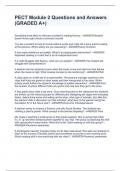Samenvatting
Samenvatting Ecologie deel 1 (ECO 1 t/m 5)
Samenvatting van het boek 'Elements of Ecology' voor deel 1 van Ecologie. De paragrafen die zijn aangegeven bij Eco 1 t/m 5 in het werkboek worden hier samengevat. De samenvatting bevat dus delen van de hoofdstukken 2, 3, 4, 6, 7, 8, 9, 10, 11, 19, 12, 13, 15 & 14 (op deze volgorde). De samenvattin...
[Meer zien]














